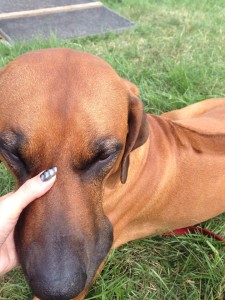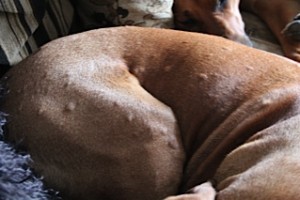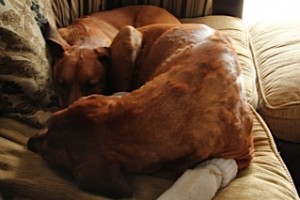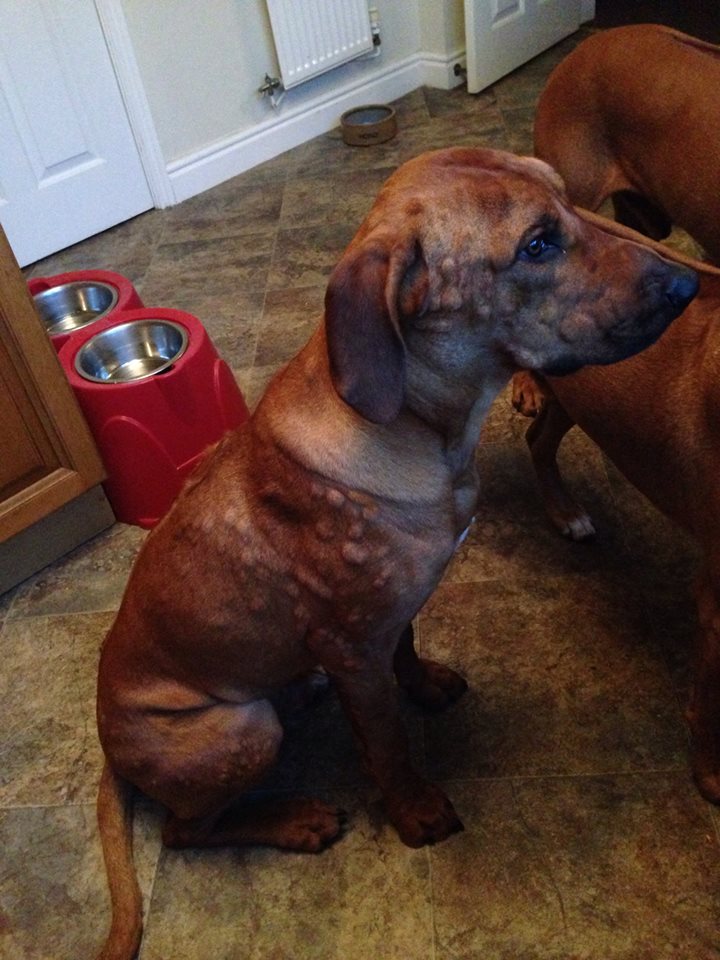There are many things that can trigger allergic reactions and hives in our animals – everything from food or medication that doesn’t agree with them, bee stings, wasp stings, nettle rash, vaccinations, flying ants, biting “critters” in the grass or undergrowth and even licking toads!
This is what happens when you decide to suck a wasp!!!

Sometimes there might be a soft swelling on the face, paws or muzzle after rooting about, and if your dog has a short coat, then he might even get some raised blotches on his body too.
This is Vidar, one of our Rhodes 2 Safety follower’s dogs who had a bad reaction to a vaccination booster. You can see through the stages of the photographs how the reaction increased in severity. Poor boy ended up wearing socks to stop him scratching because he actually made his face bleed.



The reaction can be very itchy and often the dog can scratch and rub at himself until he bleeds. The following video was sent to me by another of our followers and shows just how itchy allergic reactions can be. Click on this link where you will see how the dog tries to relieve the itching. HivesHives
Nettles, skin irritation & homeopathy
For a nettle rash or a general skin reaction, we merely bathe the area with cold water or use icepacks. You can also try a homeopathic remedy which is 1 tablet of Urtica, 4 times daily for 2 days.
Whether its medication, food, toads, frogs, wasps or bees, it’s not really a very serious problem for most dogs and is certainly not life threatening unless they either have a severe allergic reaction as in the pictures above, they react by going in to Shock, or if they are stung on the mouth/throat area. Any of these situations may cause the windpipe to swell up and make it really difficult to breathe and if the airway swells up too much, it might even cut off the breathing altogether and suffocate the animal, so remember to treat severe allergic reactions and a sting to the mouth or throat as an emergency.
If the dog begins to go in to shock, it is vital that you get it to your vet ASAP.
Always remember to ring ahead and let the vet know that you are on your way so as not to arrive only to find that he/she is out on another call.
If possible, while en route to the vet, monitor the breathing rate (how many breaths are they taking in a 10 second period), what is the heart rate and gum colour – it’s advisable to check when the dog is well to see what is NORMAL for him so you are able to detect if things are going badly.
Position the animal with his rear end raised to encourage oxygenated blood towards the brain and keep him warm and calm. With shock, TIME IS OF THE ESSENCE.
An antihistamine is required to counteract the allergic reaction, but please DO NOT give Piriton or any other antihistamine unless it has been prescribed FOR YOUR DOG by your vet. (In the UK, we always use Piriton – not Piriteze or any other type of antihistamine. In other countries, Benadryl may be given but this is not appropriate in the UK due to the ingredients in our version). If you know what dosage and what medication would be suitable, as previously prescribed by your own vet for this animal specifically, then giving antihistamine will help the symptoms to subside.
You may need to give another dose every 6-8 hours for a couple of days as the reaction may flare up again. If the reaction is more severe still, then only a trip to the vet for an injection of high dose steroids and, as any swelling to the windpipe can be a life threatening situation, please ‘phone ahead to let your vet know you are on your way and go straight over.
Please bare in mind that not all dogs (dependant upon their history or medication they may be on, or their specific breed) may be safe to use Piriton. Some dogs who fall into the herding varieties such as Border Collies, Shelties, Old English Sheepdogs etc could have a genetic defect called MDR1. If they do, then administering a drug such as Piriton can be incredibly dangerous and should be avoided at all costs. If you do not know if your pastoral breed dog is MDR1 positive or not, a simple cheek swab sent off to a genetic lab for DNA testing can put your mind at rest one way or the other. Here’s our blog on MDR1 just in case you want to read more about this mutation: MDR1 blog
If you do not have any antihistamine or your vet has not previously prescribed this for your dog, you can give them high doses of Vit-C and Nettle drops as it works as a natural antihistamine. Administer at least 2000-3000 mg of Vitamin C every 4 hours as it is water based and 30-40 drops Nettle drops.

